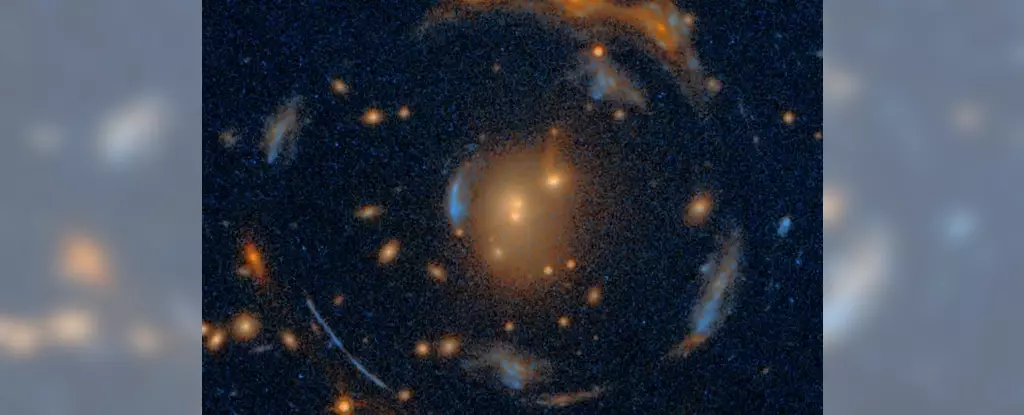Gravitational lenses serve as one of the most fascinating phenomena in astrophysics, acting like cosmic magnifying glasses that allow astronomers to gather invaluable information about celestial bodies located far beyond our own galaxy. These lenses form when massive objects like galaxy clusters warp the fabric of spacetime, creating a captivating distortion of the light emitted from objects situated behind them. The recent discovery of a notable example known as “The Carousel Lens” showcases the incredible power of gravitational lensing in revealing the mysteries of the universe.
Discovered through data from the Dark Energy Survey, the Carousel Lens represents a remarkably rare alignment of seven distant galaxies, all appearing in distorted forms due to an intervening galaxy cluster, cited as DESI-090.9854-35.9683, residing approximately 5 billion light-years away from Earth. Scientists involved in this research emphasize that such an alignment is not merely a chance occurrence; it is akin to finding “a needle in a haystack.” David Schlegel, a senior scientist at Berkeley Lab, highlights the improbability of this discovery, likening it to an exceptional galactic arrangement that spans a significant portion of the observable universe.
What makes the Carousel Lens particularly intriguing is the “funhouse mirror” effect it creates, which distorts the shapes of the background galaxies, leading to various intriguing configurations. Each of the seven galaxies, located between 7.62 to 12 billion light-years from our planet, forms multiple mirrored images through the effects of gravitational lensing. The alignment cleverly produces phenomena like the “Einstein Cross,” where light from a single galaxy appears as four separate images, indicative of how light bends around massive foreground objects. This unique setup not only provides astronomers with snapshots of distant cosmic structures but also offers invaluable insights into the underlying physics governing lensing phenomena.
The Carousel Lens stands out as a prime candidate for advancing our understanding of two of the universe’s biggest enigmas: dark matter and dark energy. Xiaoshang Huang, involved in the research team, describes the Carousel as a quintessential example of a “strong lens” within our universe. As the team analyzes this intricate configuration, they aim to construct models that will reveal the distribution of matter within the lensing cluster, offering clues about both dark and baryonic matter. The spatial diversity between the lens and the lensed objects creates a rich ground for study, presenting extraordinary prospects for measuring cosmic properties and understanding the universe’s expansion dynamics.
One of the most exciting aspects of studying the Carousel Lens is its potential to shed light on high-redshift galaxies, which are remnants from vastly different epochs in cosmic history. Among the lensed sources is a particularly intriguing candidate, labeled as Source 7, which exhibits traits of a red, quiescent galaxy. With its stellar formations likely having paused due to various astrophysical processes, Source 7 could offer clues about the phenomenon known as “early galaxy quenching.” Understanding how and why galaxies stabilize into quiescent states—often due to feedback mechanisms between central supermassive black holes and surrounding matter—could reveal vital information about the evolution of galaxies throughout history.
The Carousel Lens is more than just an astronomical curiosity; it acts as a powerful tool for probing the fabric of the cosmos. As researchers deepen their investigations into this unique alignment of multiple galaxies, they can address significant questions related to the early universe and the role galaxies play in its evolution. With each new discovery facilitated by tools like the Hubble Space Telescope and studies of gravitational lenses, astronomers inch closer to unraveling the complex tapestry of cosmic history. The Carousel Lens serves as a reminder of how interconnected our universe is, revealing relationships between its most distant regions and the fundamental forces that orchestrate its evolution. This lens not only reflects the past but also forms a beacon of hope for understanding what lies ahead in our quest to comprehend the vast, enigmatic universe.

